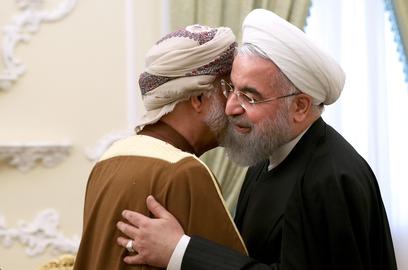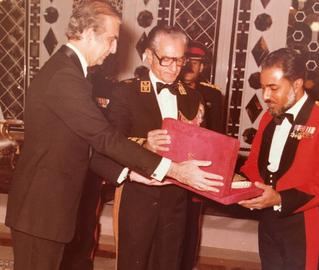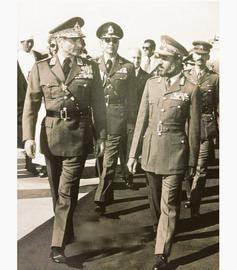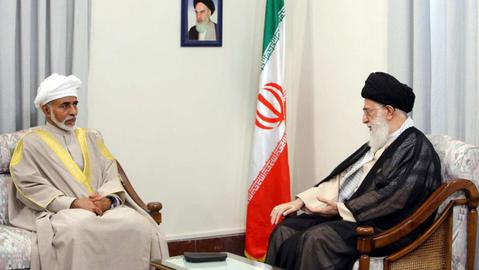It was Oman’s successful mediation that led to the historical negotiations between Iran and the US and the eventual signing of the nuclear agreement in 2015. And now, with President Trump’s withdrawal from the nuclear accord, the continuing escalation of tensions between Tehran and Washington and the return of sanctions, once again the kingdom has expressed its willingness to mediate between the two countries, announcing that it has agreed to offer an exclusive port to Iranian ships to facilitate transportation of cargo for imports and exports when the full sanctions hit [Persian link].
Unlike other countries and unlike even other Arab countries, Oman has steadfastly stood by the Islamic Republic throughout its turbulent 40 years. Why? Perhaps nothing explains it better than the words of Oman’s Sultan Qaboos himself: “I owe my kingdom to the Iranian martyrs who shed their blood on the soil of Oman.”
Ali Akbar Salehi, who had many extensive meetings with Sultan Qaboos in the course of secret US-Iran negotiations during his time as Iranian foreign minister between 2011 and 2013, quoted this statement in his memoir. The quote refers to the vital role that Mohammad Reza Shah Pahlavi played in defeating the Dhofar Rebellion and in safeguarding the integrity of Oman in the 1970s. “Although many years had passed, the Sultan was always very grateful for Iran’s help at the time,” wrote Salehi.
Throughout the years, Sultan Qaboos has always expressed his thanks to the successors of the shah for what the shah did to save his throne. For example, in 1998, when Ali Akbar Nategh Nouri visited Oman as the speaker of the Iranian parliament, the sultan told him: “When we had difficulties you helped us and we believe it is our duty to defend you.” (Quoted in Leaving Isolation Behind, a memoir by Mohammad Sadr, Deputy Foreign Minister for Arab and African Affairs under President Khatami, published in 2017 [Persian link].)
What did Iran do for Oman?
The war in Dhofar, the biggest province in Oman, was the only actual war that the shah’s Imperial Armed Forces fought. In the summer of 1972, Sultan Qaboos asked Iran to help him defeat pro-Soviet rebels in the province who were advancing in the southern part of the country. Considering that Oman lies at the south of the strategic Strait of Hormuz, the gateway for a major part of the world's seaborne crude, the sultan’s request needed an immediate answer. “Problems with the Strait of Hormuz would end our life,” Shah Mohammad Reza Pahlavi was quoted as saying.
In December of that year, five months after the sultan’s plea was conveyed to Tehran, battalions from the Khorasan 77th Army were dispatched to Dhofar. And after three years of bloody engagements, the Iranian army saved Sultan Qaboos’s throne and the territorial integrity of Oman.
It is estimated that 15,000 Iranian soldiers fought in Dhofar. The number of Iranian casualties was never officially disclosed, but various sources put the numbers at around 700 killed and 1,400 injured. Iran declared victory in late 1976 and a month later Sultan Qaboos announced that the war had ended.
What was the War in Dhofar About?
Five years before Qaboos bin Said overthrew his father Sultan Said bin Taimur in a coup d’état in 1970, dissatisfied tribal leaders in Dhofar, which borders Yemen, rose in armed rebellion against the central government and launched the Dhofar Liberation Front. When South Yemen announced its independence in November 1967 as the “People's Democratic Republic of Yemen” to signal its communist leanings, the insurgents in Dhofar changed their name to the Popular Front for the Liberation of the Occupied Arabian Gulf.
In the beginning, Dhofar’s tribal forces were armed with unsophisticated but deadly weapons like mines planted in woodlands and shoulder-fired rockets and, in their asymmetrical guerrilla warfare, they even used knives and straps made of camel leather to kill Iranian soldiers, but as the war heated up the Soviet Union started supplying the insurgents with weaponry.
For Iranian soldiers the terrain and the flora and fauna were unfamiliar. The mountainous area of Dhofar is dotted with caves, which the insurgents used as bases and which created difficulties for the Iranian soldiers. These factors enabled the insurgents to inflict heavy casualties on the Iranian military, especially in the early months.
“Considering the geographical conditions of the region from a military point of view, the war in Dhofar was one of the most difficult and outstanding anti-guerrilla operations in the history of Iran,” concludes “Unknown Facts about the War in Dhofar”, a report published by Iran’s Contemporary Political Studies and Research Institute [Persian link].
To keep the morale high, the Iranian military provided its soldiers in Oman with entertainment, including concerts by Googoosh, the superstar Iranian pop singer, and by other popular musicians. At the same time, Sultan Qaboos removed visa requirements for Iranians. “[He]provided Iranians with every facility to do their jobs without hassle,” says Mohammad Hossein Moayeddin, Iran’s chargé d’affaires in Oman during the war. “What is interesting is that they gave Iranian names to the hills that were liberated by Iranian forces.” As a sign of the unique cordial relations between the two countries, the Iranian military also received joint decorations directly from Shah Mohammad Reza and Sultan Qaboos.
Shah Mohammad Reza entered the Dhofar conflict at the height of his power to protect Sultan Qaboos’s throne and Oman’s territorial integrity. But only two years after the war ended he lost his own throne. Some Iranian forces remained in Oman to guard the liberated areas, but with the 1979 Islamic Revolution, the remaining forces left Oman and returned to Iran. The Imperial Army was nothing more than a name after a good number of its senior commanders were either executed by the revolutionary government or escaped the country.
After the Shah
Documents recently published in the United States show that with the start of the Iran-Iraq war in September 1980, Saddam Hussein, who wanted to take over the islands of Abu Musa and the Greater and Lesser Tunbs in the eastern Persian Gulf near the Strait of Hormuz, stationed military equipment and combat helicopters in Oman to use the country as a base to occupy the islands. It is not clear whether Sultan Qaboos was angry at the revolutionaries who had overthrown his savior or wanted to work with Saddam Hussein to realize his goals of pan-Arabism.
In any case, before Saddam could launch any attacks on the islands and after the US warned repeatedly that retaliatory measures by Iran could jeopardize shipping through the Strait of Hormuz, Sultan Qaboos refused to allow Saddam to put his plan into action. On the contrary, in the coming months Oman gradually became an intermediary for Iran.
When attacks on oil tankers in the Persian Gulf intensified in what became known as the Tanker War, Kuwait asked for American and Soviet forces to protect the tankers. At the time, Yusuf bin Alawi, Oman’s Foreign Minister (and who still holds the office) visited Iran to reduce tensions.
In later years, Oman played a more active role in reducing tensions between Iran and the West — including persistently trying to reduce tensions in US-Iran relations and helping to secure the release of American, British, Canadian and dual-national prisoners in Iran.
In 2011 Sultan Qaboos personally managed to secure the freedom of two American hikers who had spent more than two years in prison in Iran. They were flown to the Omani port of Muscat on Qaboos’s royal plane and were united with their families. The sultan even paid their bail of $500,000 each set by the Iranian Judiciary.
At the same time, Sultan Qaboos also managed to secure the release of a number Iranian prisoners in the US in the framework of a “prisoner swap,” although some refused to return to Iran. Also released from close to six years of house arrest in th United Kingdom was Nosratollah Tajik, the former Iranian ambassador to Jordan, who the US accused of conspiring to export US-made night-vision goggles to Iran without a license. After his release he thanked Oman.
Sultan Qaboos as Viewed by Ayatollah Khamenei
But, besides everything else, Sultan Qaboos' most important achievement was his successful mediation between the US and Iran regarding the 2015 nuclear agreement, officially known as Joint Comprehensive Plan of Action (JCPOA). It was his initiative that led to close to two years of behind-the-scenes negotiations between multiple parties including direct talks between Iranian Foreign Minister Mohammad Javad Zarif and US Secretary of State John Kerry.
However, in 2011 the sultan was not successful in his attempts to talk to Ayatollah Khamenei on the phone to tell him that President Obama had agreed to suspend sanctions if Iran slowed down its nuclear program. The reason, Iranian officials say, is that Khamenei is not in the habit of talking to world leaders on the phone. However, Khamenei has referred to Sultan Qaboos as one of the “esteemed” people in the region — and this is also not something that the Supreme Leader is in the habit of doing [Persian link].
At the height of protests in the aftermath of the disputed 2009 election, Sultan Qaboos was the only foreign leader to visit Iran and meet with Ayatollah Khamenei. This was the first time after the overthrow of the shah that he visited Iran and it signaled a show of the support for the regime of the Islamic Republic.
The Support Continues
In the years following the historic nuclear agreement, Oman has continued to try to defuse tensions in the fragile relations between Iran and the US. For example, at one point the production of heavy water by Iran’s Atomic Energy Organization exceeded the limit set by the JCPOA. Since it was not possible to find a buyer for the excess heavy water in the short run, Iran was in danger of being in violation of the agreement. Oman came to the rescue and allowed Iran to store the heavy water in an Omani port to prevent possible repercussions and tensions.
Now the US has withdrawn from the agreement that Oman played a vital role in bringing about and the sanctions against Iran have been re-imposed. Yusuf bin Alawi has said that, once again, Oman is ready to mediate between the US and the Islamic Republic. According to reports, during his visit to the US in late July, Alawi discussed “reducing Iran-US tensions” with Secretary of Defense Jim Mattis and Secretary of State Mile Pompeo.
With such a history it is no wonder that many people, especially in Iran, view any action from Oman as a sign of possible secret negotiations between Iran and the United States through the auspices of Sultan Qaboos.
Sultan Qaboos has ruled longer than any other Arab head of state. He is now 77, has no children and has no designated heir apparent. But whoever succeeds him is not likely to feel as beholden to Iran for what the shah did as he does. If the conflicts between Iran and the West remain unresolved, his absence will be a great loss for the Islamic Republic.
visit the accountability section
In this section of Iran Wire, you can contact the officials and launch your campaign for various problems




























comments